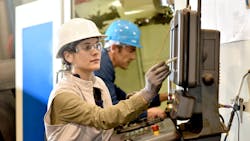Over the last two decades, as Millennials joined the workforce in significant numbers, industry has been faced with an ever-growing worker shortage. Much of the initial impact on the industrial workforce in the U.S. stemmed from the offshoring of numerous manufacturing jobs and industry’s reputation as a workplace that was often dark, dirty and dangerous.
Today, the industrial landscape in the U.S. is significantly different. Manufacturing jobs are growing as production returns to the U.S. and factories are cleaner and safer than ever (largely due to automation). Yet the workforce shortage persists as a new generation—Gen Z—enters the workplace to replace retiring Boomer and Gen X workers.
Years of educational outreach from the manufacturing industry to attract younger workers has helped to a certain degree, but the effects of offshoring and industry’s hard labor history still have a negative impact on perceptions. This can be seen in the ongoing worker shortage, which currently stands at more than 600,000 unfilled manufacturing jobs, according to the U.S. Department of Commerce.
To help the manufacturing industries better understand Gen Z workers, Soter Analytics, a global safety technology company, conducted a survey of more than 2,000 Gen Zers in the United States.
Probably the most striking result of the survey is that only 14% of Gen Z say industrial work is a career they’d consider. This low level of positive response to industrial work is likely connected to the fact that 25% of Gen Z believe work conditions are unsafe in industrial jobs, 20% think the pay is low and 14% feel the benefits aren’t good.
Takeaways for industry
Despite the low opinion of manufacturing work held by many Gen Zers, Soter Analytics study reveals some key insights that could be addressed by industry to sway Gen Z’s impression of industrial work.
For example, 32% of Gen Z say a clear promotion path or opportunities to move into a corporate position would incentivize them to consider industrial work, while 29% say if industrial jobs were paid above the national salary average for entry level workers, they’d be incentivized to consider them.
Interestingly, 17% say they’d be incentivized to consider an industrial job if they knew someone who was working in the space and liked it—which suggests that campaigns highlighting Gen Z workers currently working in industry could be a significant influencing factor.
One stereotype about Gen Z workers is that they have high demands for workplace flexibility, and Soter Analytics’ study tends to support that stereotype. According to the study, 26% of Gen Z think the hours are rigid in industrial work and 40% say that flexible hours/workdays are a primary deciding factor when considering a job offer. Twenty-six percent of Gen Z say flexible working hours or days would incentivize them to consider industrial work.
Beyond pay and workday flexibility, use of technology is another critical factor for industrial companies to consider as they seek to attract Gen Z workers. The Soter Analytics study showed that 27% of Gen Z wants to work for a company on the forefront of new technologies—such as drones, connected devices, artificial intelligence and virtual reality. All of which are increasingly finding a home in manufacturing through industry’s digital transformation.
Key to tapping into Gen Z’s desire to work with new technologies is that 30% feel more equipped to learn new technologies than generations that came before them and 33% want to work for a company that is actively embracing new technology to help employees do their job.

